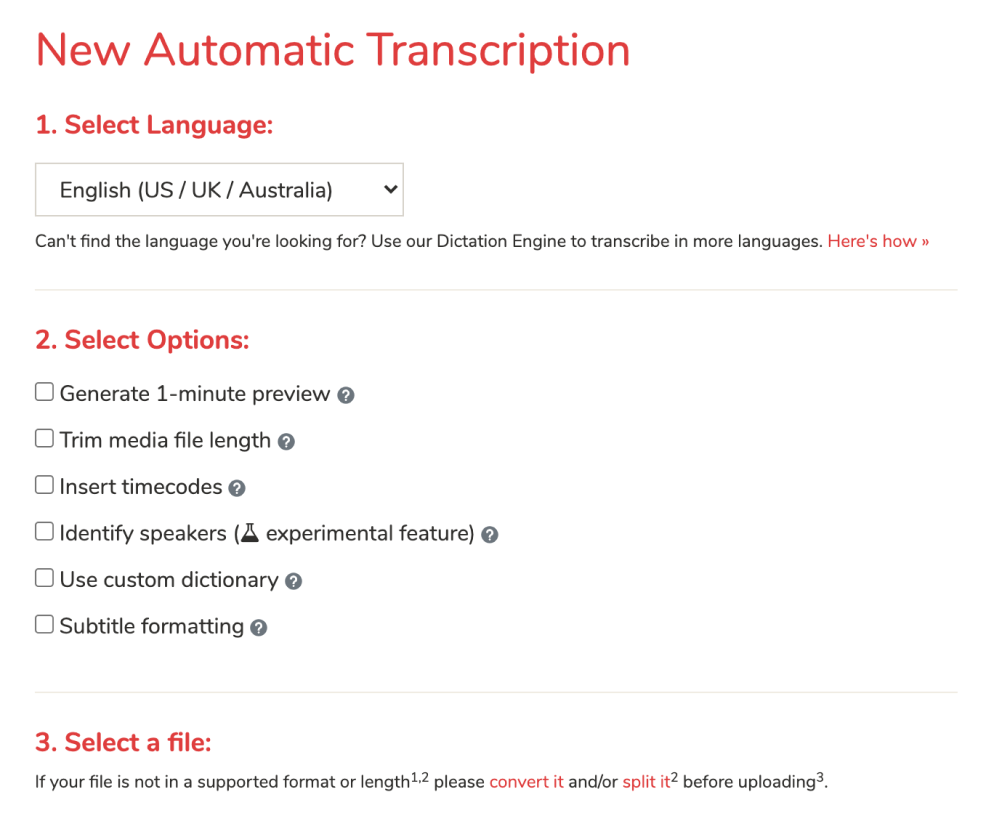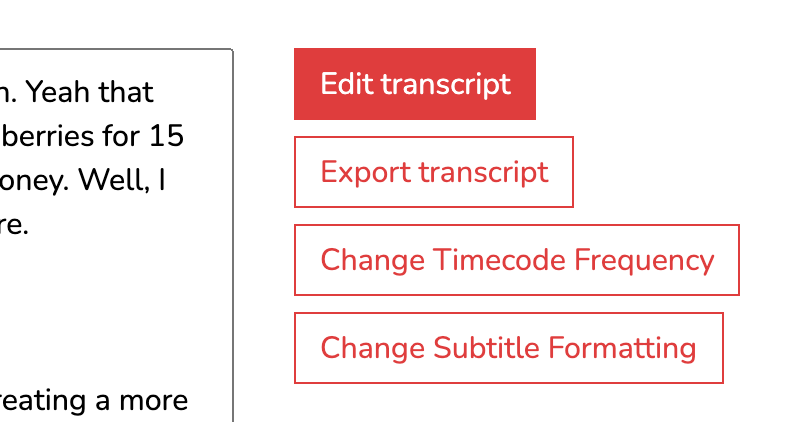How to Transcribe Audio to Text [in 2025]
Transcribing audio files to text can be a rather tedious and time-consuming process. Thankfully, in 2025, converting an audio to a text transcript is much easier. Transcribe is the most comprehensive and secure online transcription software for transcribing audio and video 2-3x faster using both automatic and manual transcription modes.
How to Transcribe Audio with Automatic Transcription
1. Select automatic transcription mode for your audio file

Automatic transcription works best for clear and well-recorded audio. Transcribe's machine learning based automatic transcription feature converts audio files to a text transcript with great accuracy.
You will be able to convert speeches, interviews, phone calls, audio notes and lectures in minutes. You can then edit, or export the transcript as a Microsft Word file.
We support almost all popular audio and video file formats (mp3, mp4, m4a, wav, etc.).
2. Upload your audio file
Transcribe offers quite a few transcription options that you can customize before uploading your audio file.
Options include preview transcription, speaker identification, insertion of timecodes in the transcription and subtitle formatting.

We've designed Transcribe from the ground-up with privacy and security in mind, and so we delete the audio and video files you upload after processing them and do not keep any copies of them. Read more about how we handle your data securely here.
3. Download your transcript in various formats
After uploading, you can track the status of your transcription.
Our transcription software typically transcribes the audio faster than the length of the audio uploaded. On average, an hour long audio or video file is transcribed in less than 30 minutes.
We also send you an email notification as soon as the the transcription is ready.
Once the text transcript is ready, you can export it as a Word document or as a subtitle (SRT or VTT) file if you had enabled that option during upload.
Read on to find out how you can edit the machine generated transcript.
How to Transcribe Audio Faster using Self Transcription
If you prefer transcribing an audio file yourself, Transcribe helps you speed up the process by at least 2-3x.
Here's a step-by-step guide to convert audio to text yourself:
1. Select "Self Transcription" mode for your audio file

You can use our self transcription to create a new transcript yourself using various time-saving features that Transcribe provides.
You can also use our self transcription feature to edit the transcript generated by the automatic transcription mode. If you need to edit an automatic transcript, click on the "Edit Transcript" button in the sidebar of the transcript page:

If you need to create a new self transcription, click on "New Self Transcription" from Step 1 above.
2. Choose the audio or video file to be transcribed
Our self transcription editor interface provides an integrated editor + media player.
To begin transcription, click on the "Choose audio/video" button to load the recording that you wish to transcribe. We support several common audio and video file formats.

Once you choose the file, a media player will open up right above the text editor.
3. Slow down audio and transcribe it

Transcribe provides several keyboard shortcuts for controlling the playback of the media file. You can slow it down, rewind or skip forward using these shortcuts.
- Esc: pause/resume
- F1: slow down
- F2: speed up
- F3: rewind 2 seconds
- F4: forward 2 seconds
- F6: insert timestamp
Mac users: switch your F1-F11 keys to function as standard function keys
Transcribe's tightly integrated player & editor can still halve the time it would have otherwise have taken you switching between a media player and an editor, while juggling with a mouse and keyboard.
You can slow the audio or video down, listen to it and just type along. Be sure to use the handy keyboard shortcuts mentioned above to effortlessly control the audio playback to match your typing speed.
Transcribe will automatically save every single keystroke. The transcript is stored in your browser and is not sent to our servers. This data is persisted even if you restart your browser or computer as long as you don't clear your browser's cookies or cache.
4. Transcribe the audio using Dictation (voice typing)
Tired of typing? You can use the dictation feature to give your fingers a break.
To use dictation, click on the green "Dictate" button. Once it turns orange, you can begin speaking.

Simply listen to the audio in a headphone and repeat what you hear in your own voice. Transcribe's fast & highly accurate dictation engine will convert your voice to text.
We typically find this method to be 2-3x faster than typing.
While we work on improving the quality of fully-automated machine transcription, you can leverage dictation as a time-saving technique. We support English, Spanish, French, Hindi and almost all other European & Asian languages. Please read this detailed guide on converting your speech to text using dictation.
5. Use Templates, auto loop and foot pedal features
Be sure to explore the Templates feature using which you can set certain shortcuts to expand into longer words or sentences.
For example, you can set "S1:" to expand to "Speaker 1:" automatically, when you type "S1: ".
You can also use the auto-loop feature to get the audio or video to automatically pause for a few seconds while you type and then resume, without you having to press pause and play each time.
Transcribe also supports the use of a foot pedal for efficient transcription. Transcribing using a foot pedal allows you to free up your hands to focus on typing while using your feet to control audio playback. If you do a lot of transcriptions or you're a professional transcriptionist, you can save yourself a lot of idle time using a foot pedal. Saving 2 seconds with every play/pause will quickly add up to a good increase in productivity, allowing you to hyper-optimize your workflow and do more transcriptions in less time.
Transcribe supports the following foot pedals:
- Infinity USB Foot Pedal
- Olympus RS26, RS27, RS28, RS31
- vPedal vP-1 USB pedal
- Philips ACC2310
After you load your audio or video, simply click on the foot pedal icon in the toolbar below the player to get started.
6. When you are done, export your transcript
When you are done transcribing, you can export the text as a .doc file to your computer - just click the export icon in the toolbar above the editor. We affix the date and time to the end of the downloaded file's name so you can easily track multiple versions of your work.
If you enabled the subtitle feature in our automatic transcription software, you will also be able to download the transcript as a subtitle or captions file in SRT or VTT formats.
Still have Questions?
Please refer to our Frequently Asked Questions for potential answers. If you have any other questions or just want to say hello, feel free to email us at: contact@wreally.com.